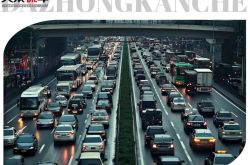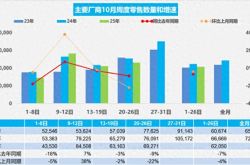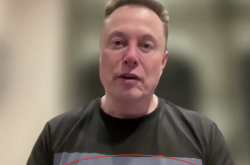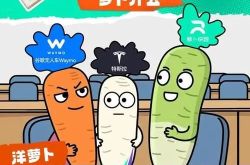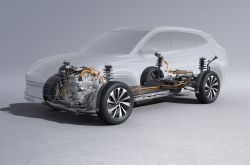Xiaopeng Humanoid Robot Showcases Strength at Shanghai Auto Show
![]() 05/06 2025
05/06 2025
![]() 648
648
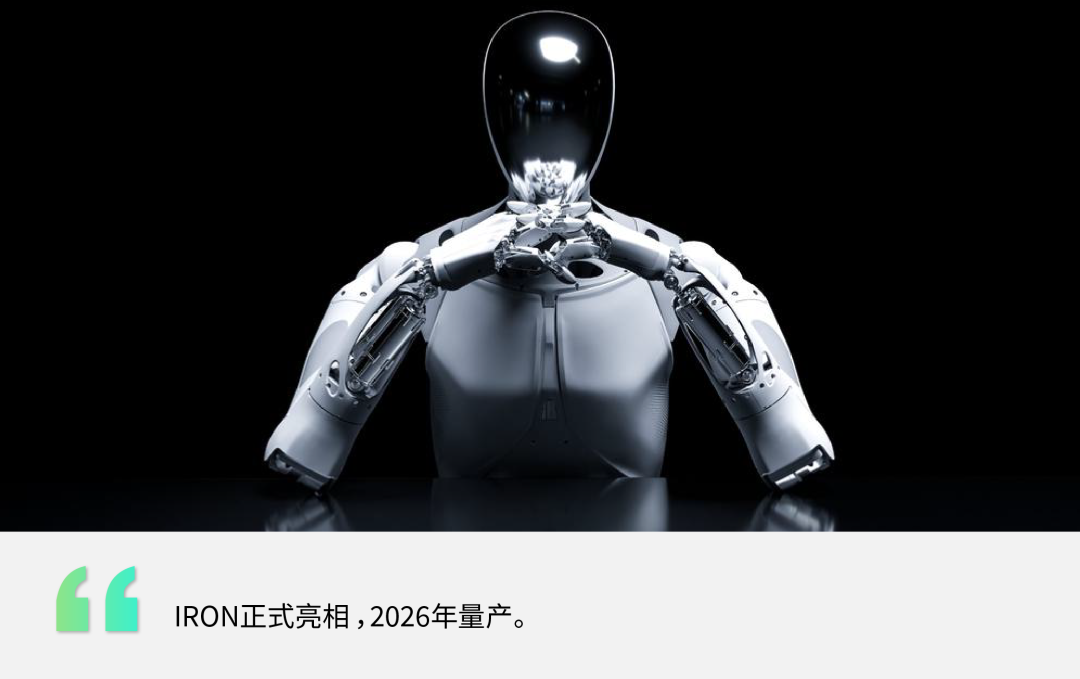
Author|Mao Xinru
This Shanghai Auto Show was a bit of a reversal. Cars, typically the main stars, were overshadowed by a robot.
This robot traveled from Shenzhen to Shanghai aboard the Xiaopeng X9, served as a car model at the show, directly introduced the company's automotive products, and even drew visits from 360 founder Zhou Hongyi and former French Prime Minister Jean-Pierre Raffarin.
Image source: Sina Auto Weibo
This "new superstar" is Xiaopeng's self-developed AI robot, Xiaopeng IRON.
There are three main reasons why IRON stole the spotlight from cars at the auto show:
This was Xiaopeng IRON's first official public appearance;
Among the robot car models at this auto show, Xiaopeng IRON is the only bipedal robot fully developed in-house by an automaker;
By showcasing its new car, robot, and land aircraft carrier together, Xiaopeng demonstrated its new "AI+automotive" ecosystem to the public.

IRON: A Chinese Automaker's Example of "Creating Humans"
In fact, IRON is not Xiaopeng's first foray into the field of humanoid robots. As early as 2020, Xiaopeng began laying out its strategy in the robot sector.
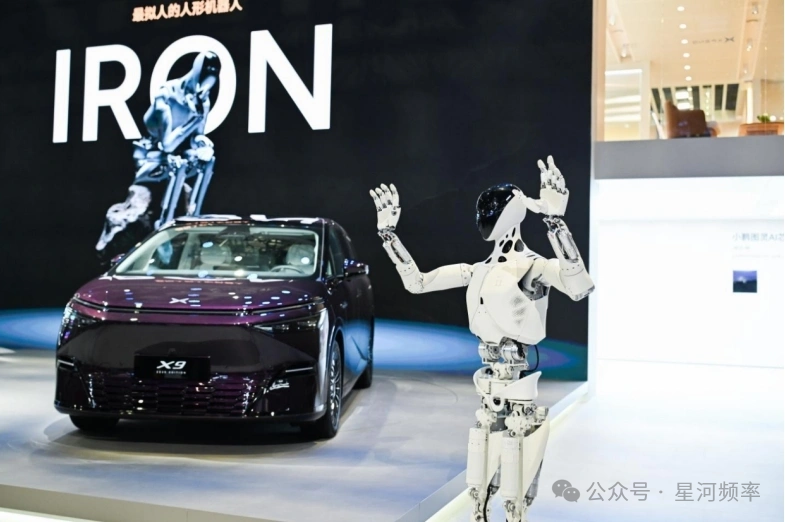
2020: Xiaopeng acquired the quadruped robot enterprise "Doggo" and established Pengxing Intelligence, entering the footed robot sector
October 2023: Xiaopeng released its first humanoid bipedal robot, PX5
November 2024: Xiaopeng officially unveiled the AI robot IRON at its AI Technology Day event, but it did not make an appearance then
January 2025: At Xiaopeng's annual meeting, IRON demonstrated its walking ability for the first time, albeit with a less natural gait
April 2025: Xiaopeng IRON made its official public debut at the Shanghai Auto Show with a steady gait
Just one year after the release of PX5, Xiaopeng brought IRON back into the public eye. Compared to PX5, IRON has undergone a complete overhaul in terms of both appearance and software and hardware.
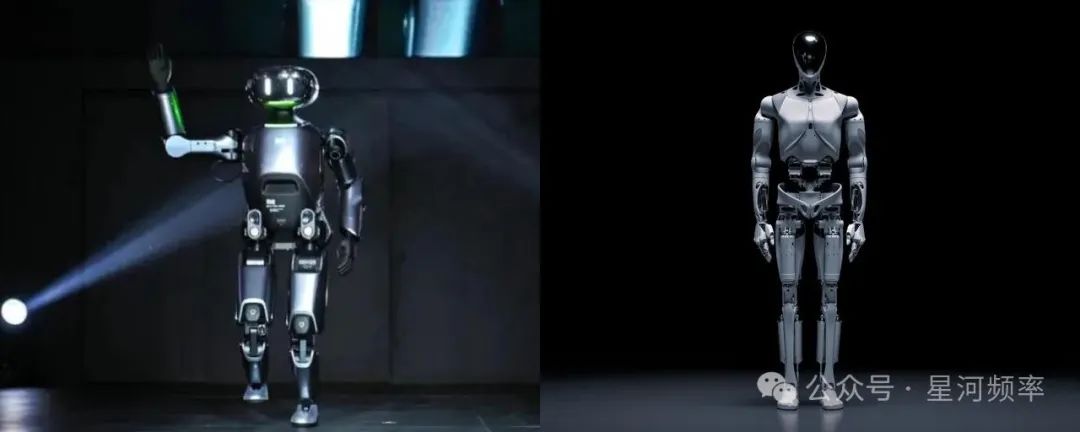
Left: Xiaopeng PX5, Right: Xiaopeng IRON
IRON is the first full-size humanoid robot under Xiaopeng Motors, standing at 178cm tall and weighing 70kg. It adopts a 1:1 bionic human body design, replicating real human bones, muscles, and sensory systems.
With a walking speed of 1.2m/s and 62 degrees of freedom throughout its body, it has the second-highest number of degrees of freedom among publicly disclosed robots, supporting complex gaits such as marching and backward walking.
IRON is positioned as an "L3-level intelligent assistant for industrial scenarios," aiming to empower intelligent manufacturing and service industry upgrades through high precision, high flexibility, and intelligent technology.
The reason Xiaopeng positions IRON at L3 level is that most humanoid robots in the industry are currently at L2 level and are striving to advance to L3 level.
With the continuous development of humanoid robots, referring to the L1-L5 classification in the field of autonomous driving, the intelligence level of humanoid robots is also classified into L1-L5. Xiaopeng's definitions are as follows:
L1: No autonomous control, requiring full manual control;
L2: Basic assisted intelligence, requiring a high degree of manual control;
L3: Embodied intelligence, with moderate manual control, which is the current mass production target of humanoid robot companies;
L4: Self-growing intelligence, enabling light manual control;
L5: Fully autonomous, requiring no manual control.
The key to IRON's strong attraction at the auto show lies in Xiaopeng's integration of its vehicle manufacturing technology into the robot.
The first major highlight of IRON is its intelligent brain. Xiaopeng has equipped IRON with its self-developed Turing AI chip, system, and algorithm, collectively known as the "three-pronged axe."
First is Xiaopeng's self-developed Turing AI chip, with a computing power of 3000T, supporting local operation of 30B parameter large models with a computing power utilization rate of 100%.
At the auto show, the cordial interaction between IRON and He Xiaopeng was made possible by the Tianji AIOS system, which endows IRON with natural language reasoning and logical decision-making abilities, allowing it to receive voice, gesture, and visual commands and provide users with emotional and thoughtful responses.
By reusing Xiaopeng's XNGP autonomous driving algorithm, IRON possesses the abilities of environmental perception, dynamic obstacle avoidance, and path planning.
At the same time, equipped with Xiaopeng's AI Hawk Eye vision system, IRON achieves 720° environmental modeling and obstacle prediction, supporting dynamic gait adjustment.
The second major highlight of IRON is its high-precision and high-strength task manipulation capabilities.
Xiaopeng uses a combination of "planetary roller screws + harmonic reducers" for IRON's bionic joint design, with a torque density 20% higher than the previous generation.
To make the robot more human-like and capable of being deployed in a wider range of application markets, Xiaopeng has also equipped IRON with dexterous hands.
IRON's dexterous hands have 15 degrees of freedom, equipped with tactile sensors and miniature linear actuators, with a single finger capable of supporting a load of 3kg and supporting precise operations at the 0.1mm level.
At the end of last year, IRON participated in the assembly of parts for the P7+ model at Xiaopeng's Guangzhou factory, completing tasks such as screwing and part handling.
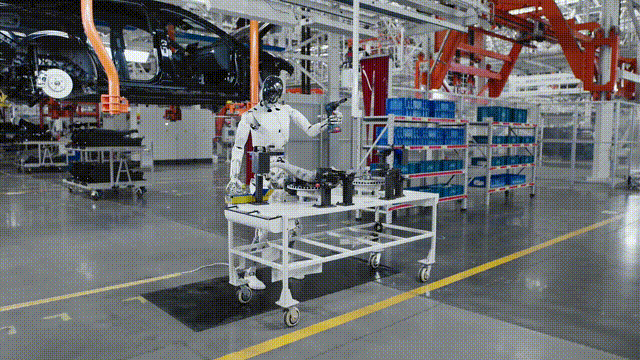
Compared to other car models exhibited at the auto show, Chery Mornine focuses more on service scenarios, GAC GoMate emphasizes its autonomous driving genes, while IRON highlights its industrial attributes, directly addressing the pain points of manufacturing efficiency improvement.

In the race of automakers "creating humans," Tesla has a slight edge over Xiaopeng
Currently, more than 20 automakers globally have laid out their strategies in the field of humanoid robots, broadly divided into two camps:
Full-stack self-development: Tesla (Optimus), Xiaopeng (IRON), GAC (GoMate)
Ecological cooperation: Chery (developing Mornine in collaboration with AiMOGA), BYD (investing in Zhiyuan and Parsini)
Among the full-stack self-development camp, GAC has chosen wheeled-legged robots, while Tesla and Xiaopeng have opted for more technically challenging bipedal humanoid robots.
Tesla and Xiaopeng have always had a "love-hate" relationship, whether in car manufacturing or robot development.
To be frank, Xiaopeng IRON and Tesla Optimus bear some resemblance. For example, both robots choose a humanoid body structure design, with "face masks" on their heads, and both opt for silver-white, light-colored schemes.
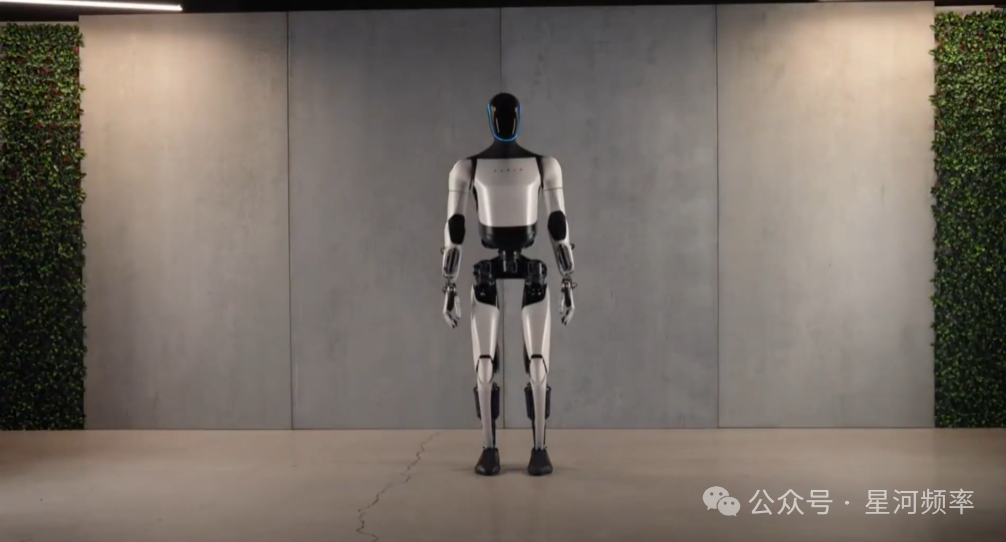
Tesla robot Optimus Gen-2
However, appearance cannot define a robot's capabilities; performance parameters are the only proof of product strength.
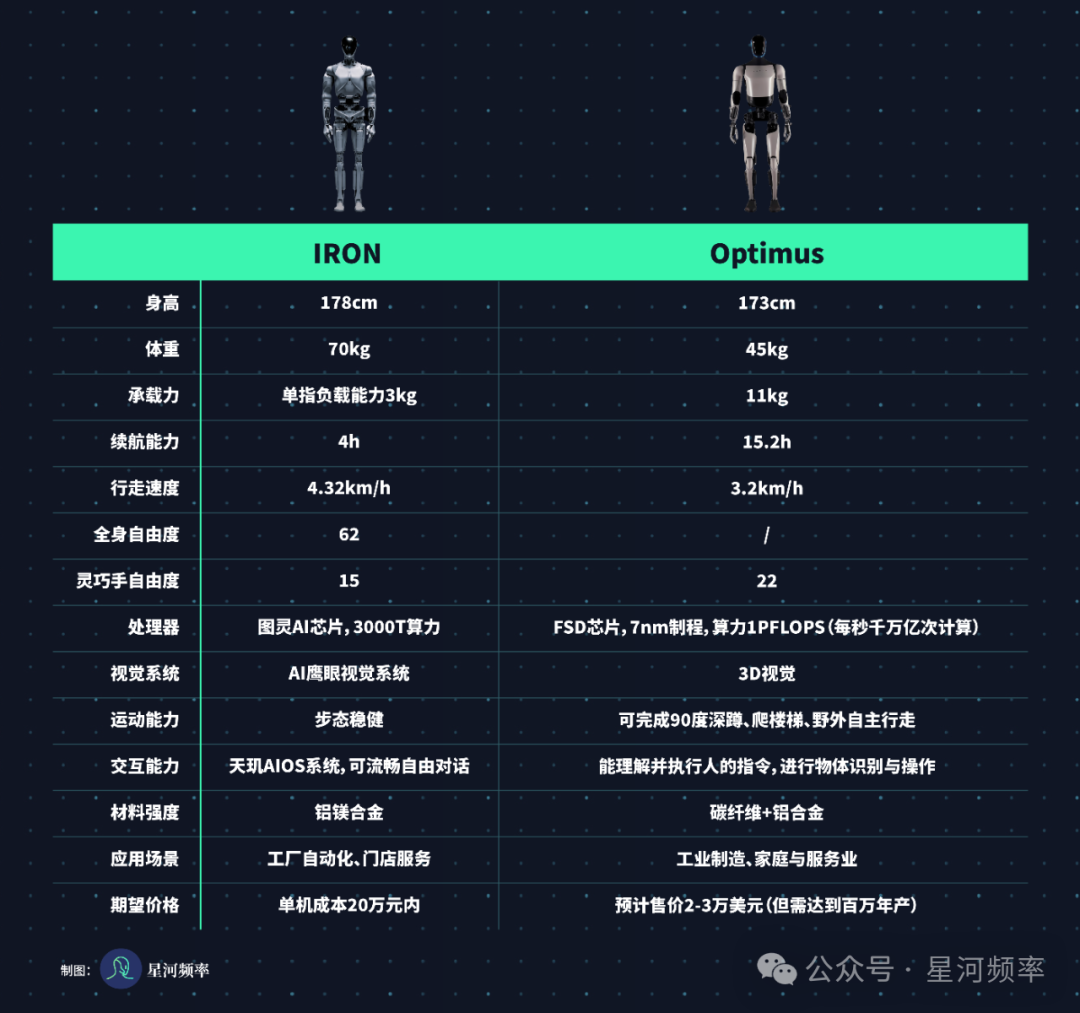
Since Optimus Gen-3 has not released all its parameters, Optimus Gen-2 parameters are used for the undisclosed parts
From a performance parameter perspective, Tesla's Optimus still outperforms Xiaopeng IRON.
After all, He Xiaopeng once said that without 50 billion yuan, a humanoid robot cannot be made, and what Musk lacks the least should be money.
From a technical perspective, the two automakers share many similarities in "creating humans."
The most obvious manifestation is that they both apply chips and algorithms used in automobiles to robots.
IRON is equipped with the same chip and system as Xiaopeng's AI car P7+, supporting end-to-end large model training and real-time decision-making, enabling the robot to possess multimodal interaction capabilities.
Optimus relies on Tesla's Dojo supercomputer and FSD chip, with computing power concentrated in cloud collaboration, while local computing power focuses on low-latency response. Its AI system shares a data framework with automobiles, enhancing learning efficiency.
At the same time, both robots adopt vision technology sourced from automobiles. IRON is equipped with the "Hawk Eye vision system," while Optimus's head is equipped with Tesla's FSD camera, both using pure vision algorithms to achieve autonomous navigation.
In addition, to enhance the robots' performance, the two automakers have taken some "similar paths" to the same goal.
To achieve better driving performance, IRON adopts a harmonic reducer + planetary roller screw solution, balancing precision and load capacity; Optimus, on the other hand, uses a screw + tendon drive, focusing on optimizing execution efficiency.
To reduce the weight of the robots, IRON focuses on the integrated design of motors and actuators for weight reduction, while Optimus reduces the weight of joints through material optimization.
Judging from the current progress of implementation, IRON has already been to Xiaopeng's Guangzhou factory to participate in practical training, with a relatively clear commercialization path.
Optimus has established a pilot production line at Tesla's Fremont factory, mainly for internal logistics, but due to supply restrictions of rare earth magnets, the mass production schedule has lagged slightly.
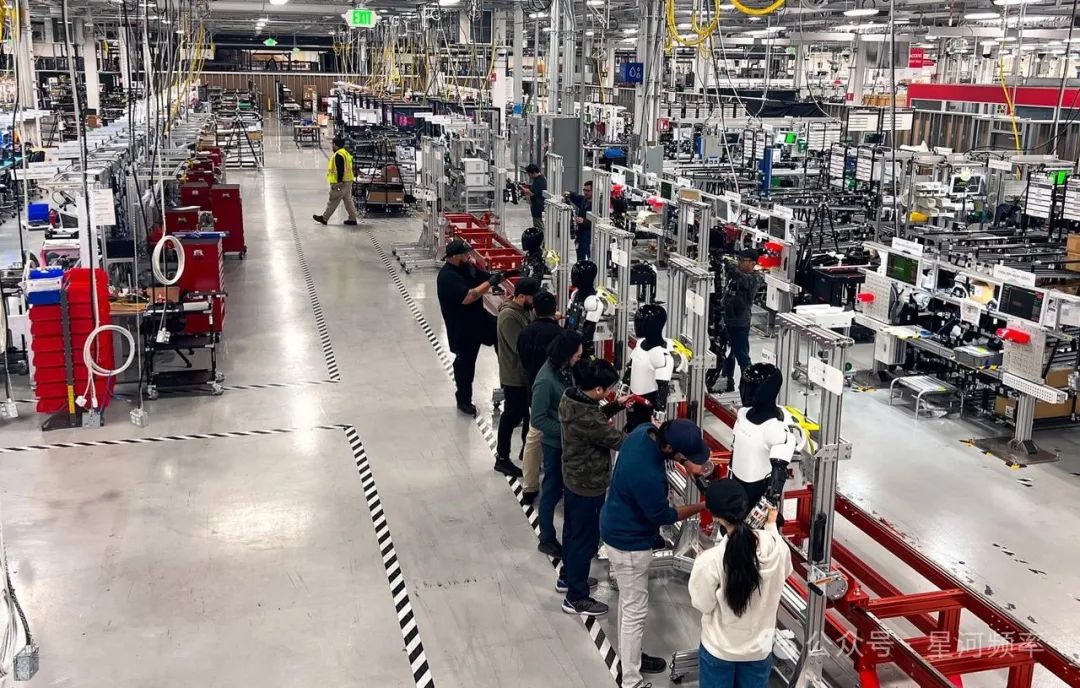
Tesla Optimus Humanoid Robot Pilot Production Line
Although Optimus outperforms IRON in terms of performance, IRON has an advantage in the supply chain.
Xiaopeng possesses a mature domestic supply chain and abundant resources, giving it a natural advantage in optimizing robot performance and reducing robot costs.
Tesla, on the other hand, is currently facing issues with rare earth supply. Rare earth magnets are key materials for manufacturing high-performance motors, sensors, and other core components of robots. If cooperation on rare earths does not go smoothly, the mass production of Optimus will be further "choked."
In terms of short-term route selection, Xiaopeng IRON and Tesla Optimus also exhibit differences between "pragmatism" and "all-round vision."
Xiaopeng IRON has clearly targeted industrial scenarios in the short term, with future goals of positively impacting manufacturing and service industries by improving quality and efficiency.
Tesla Optimus, on the other hand, has always emphasized its ecological integration capabilities. Currently, Optimus has mastered multiple skills covering both industrial scenarios and home environments. It is evident that Tesla aims to create a fully ecological intelligent assistant.
With the continuous integration of AI large models and embodied intelligence, humanoid robots are expected to become another growth pole beyond smart cars, reshaping the efficiency boundaries of manufacturing and service industries.

The key for automakers to create humanoid robots lies in reconstructing production processes
Tesla's mass production plan for Optimus has been relatively clear – achieving mass production of thousands to 10,000 units this year, 50,000 to 100,000 units in 2026, and 500,000 to 1 million units in 2027.
However, such mass production targets have raised questions from many people due to economic considerations.
Xiaopeng's path selection reveals a deeper logic: humanoid robots are not meant to replace workers but to reconstruct production processes.
Why are automakers not satisfied with just making good cars?
The answer to this question may lie in the wave of Industry 4.0.
Not long ago, the Kepler humanoid robot K2 landed at SAIC-GM and completed on-site practical training.
It is reported that the basic version of Kepler K2 costs only $30,000 and can replace the efficiency of 1.5 workers under an 8-hour workday. According to calculations in the Yangtze River Delta manufacturing industry, its investment return period can be controlled between 1.5 and 1.8 years.
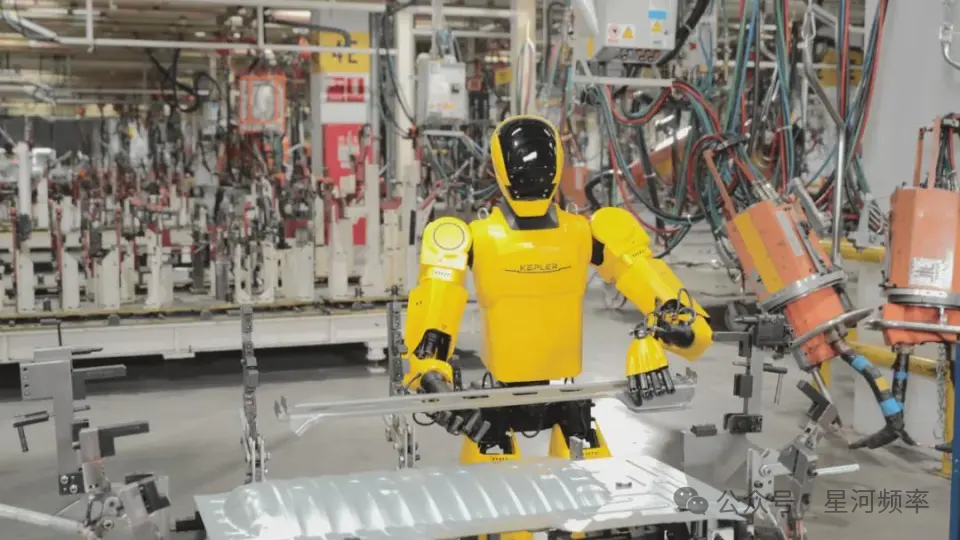
Although the outside world has doubts about the true commercial value of humanoid robots, humanoid robots have indeed initiated the first wave of innovation in the manufacturing industry, which serves as their "testing ground."
At the same time, this represents a "two-way rush" towards industrial and technological upgrades.
The explosion of demand for flexible manufacturing has become the value anchor for humanoid robots.
In industrial environments, humanoid robots can quickly adapt to different workstations, tools, and task requirements with their bipedal mobility, multi-joint operation, and visual perception systems.
Moreover, through tactile feedback and adaptive control technology, robots can complete the assembly of deformable materials, which precisely covers "semi-flexible processes" such as material quality inspection that traditional industrial robots cannot handle.
Currently, in automobile manufacturing, robots like UBTECH can already perform tasks such as battery sorting and emblem installation. Through swarm intelligence technology and cross-field pure visual perception technology, they achieve multi-robot coordination and continuous sorting of dynamic targets, significantly enhancing production line flexibility.
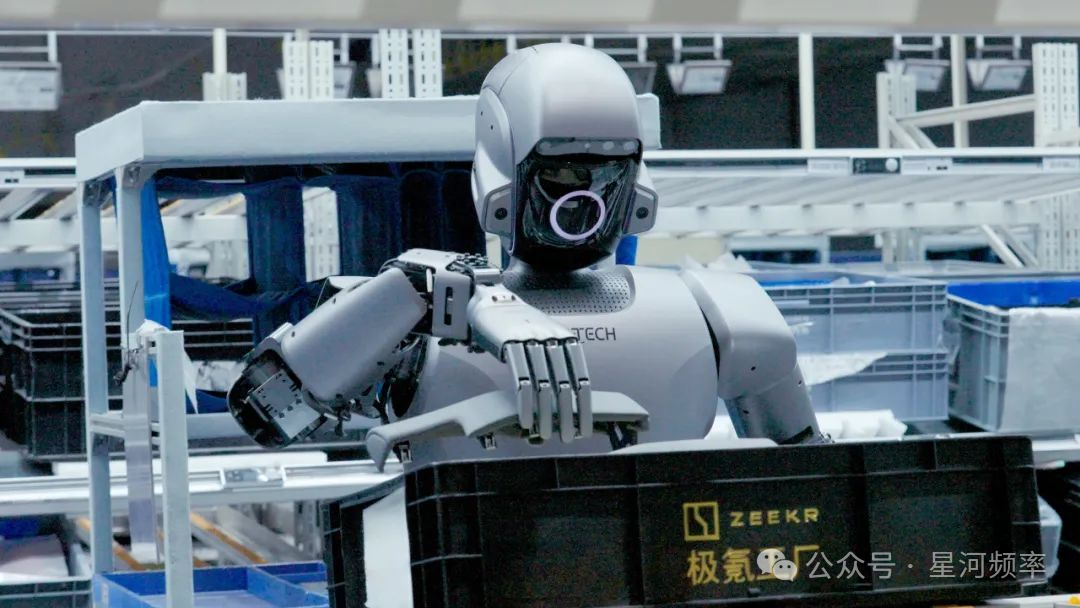
Moreover, in the age of Industry 4.0, customer demands have become increasingly personalized, posing a significant challenge for traditional robotic arms to adapt to frequent production line changes. Humanoid robots, however, can swiftly switch between tasks due to their rapid programming capabilities and modular design.
Take Tesla's Optimus as an example; it efficiently sorts 1,200 pieces per hour in battery sorting tasks, leading to a direct 300% increase in efficiency.
"Non-standard + heavy-duty" work environments necessitate an even greater emphasis on "human-robot collaboration".
Enhanced by AI algorithms, humanoid robots exhibit generalization capabilities in complex scenarios, adept at handling intricate problems in unstructured environments. This is particularly evident in precision assembly and hazardous material handling, where their millimeter-level precision can be invaluable.
In the automotive final assembly process, for instance, 80% of blue-collar workers are engaged in non-standardized tasks such as screwing and installing car doors. Through on-site training, humanoid robots can gradually master these skills, enabling them to replace humans in high-difficulty operations.
Furthermore, humanoid robots serve as "flexible interfaces," bridging traditional automated equipment with manual processes.
At the Zeekr factory, UBTECH robots collaborate with AGVs to manage large-size material bins and optimize path planning through intelligent decision-making technology, thereby minimizing production line downtime.
In the short term, XPeng's focus on IRON for industrial scenarios not only ensures self-sustaining commercial value but also maximizes the use of this testing ground for technological advancements.
Long-term success for any "human-making" enterprise hinges not on single-point technological breakthroughs but on achieving ecological synergy and reconstructing industrial value.
Humanoid robots are evolving from mere "tools" to indispensable "partners".
In this marathon, the key to defining the infrastructure of the next generation of industrial civilization lies in establishing a closed loop encompassing "hardware, algorithms, scenarios, and ecology".



